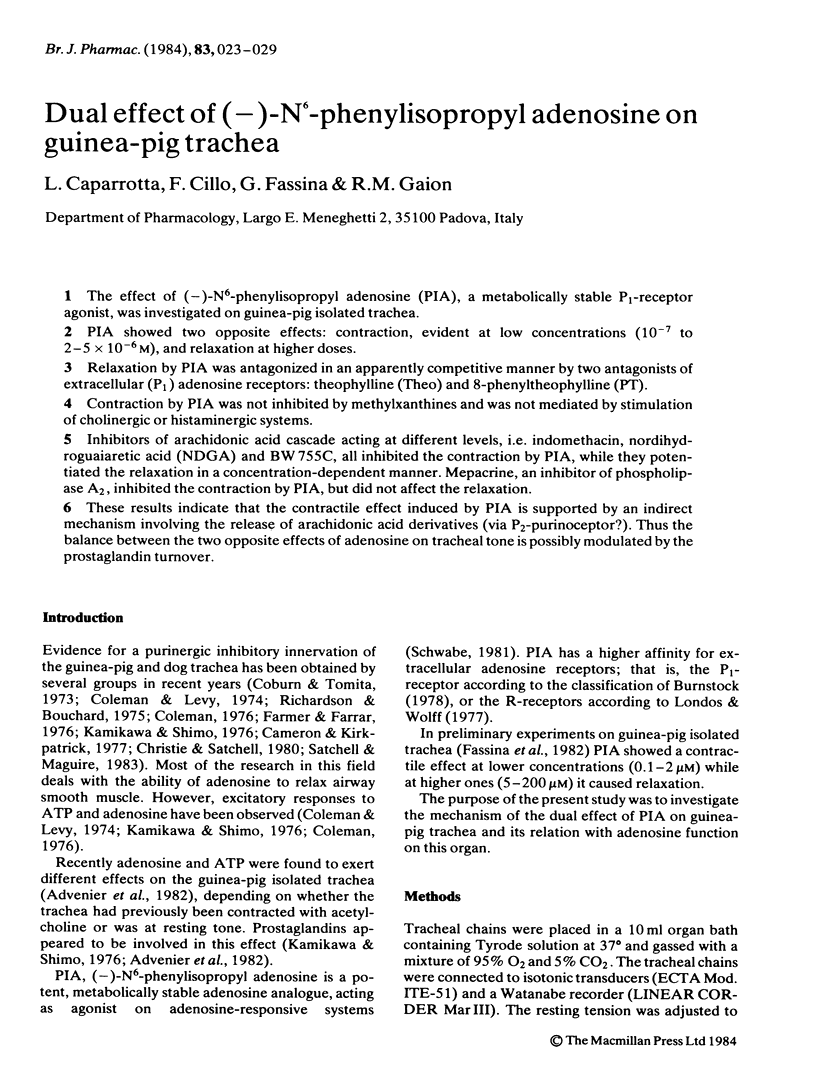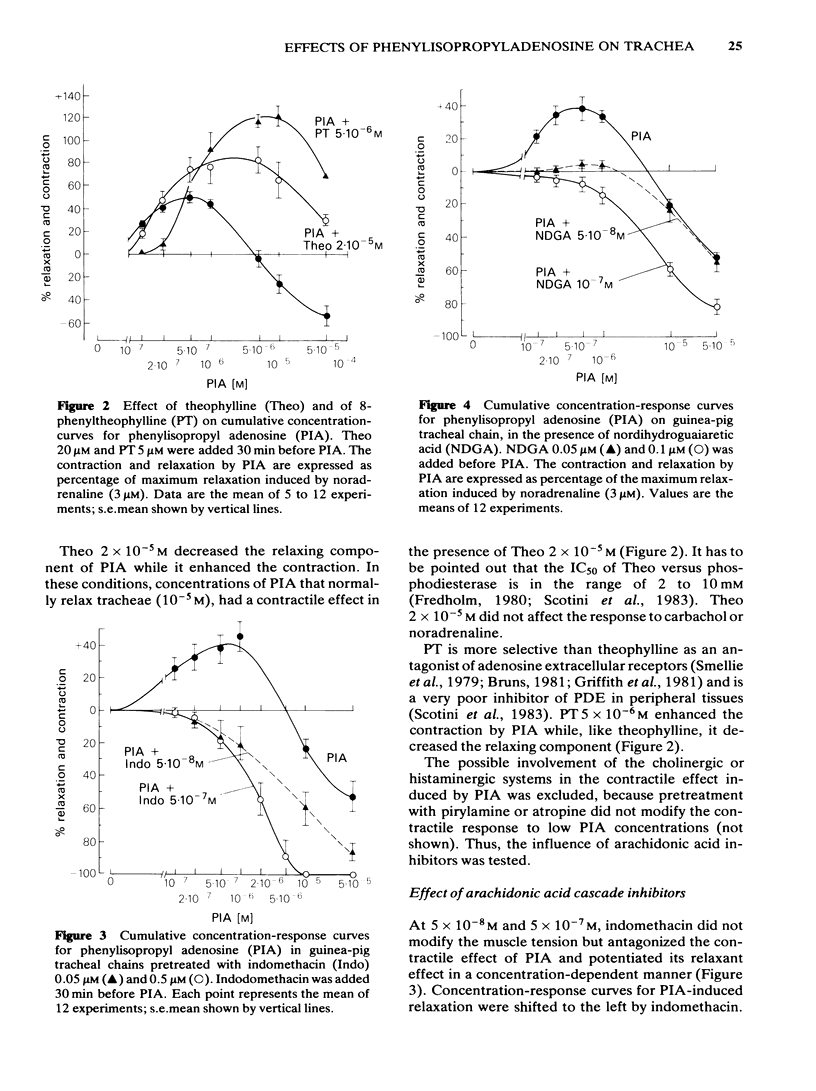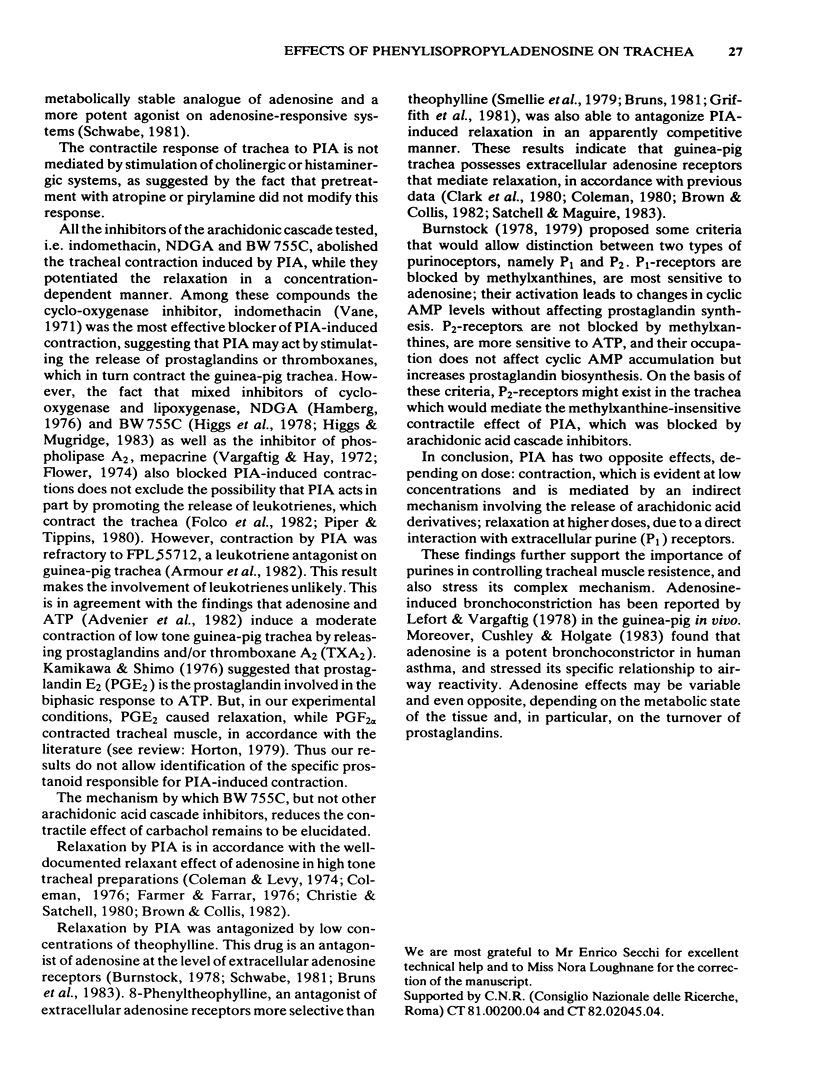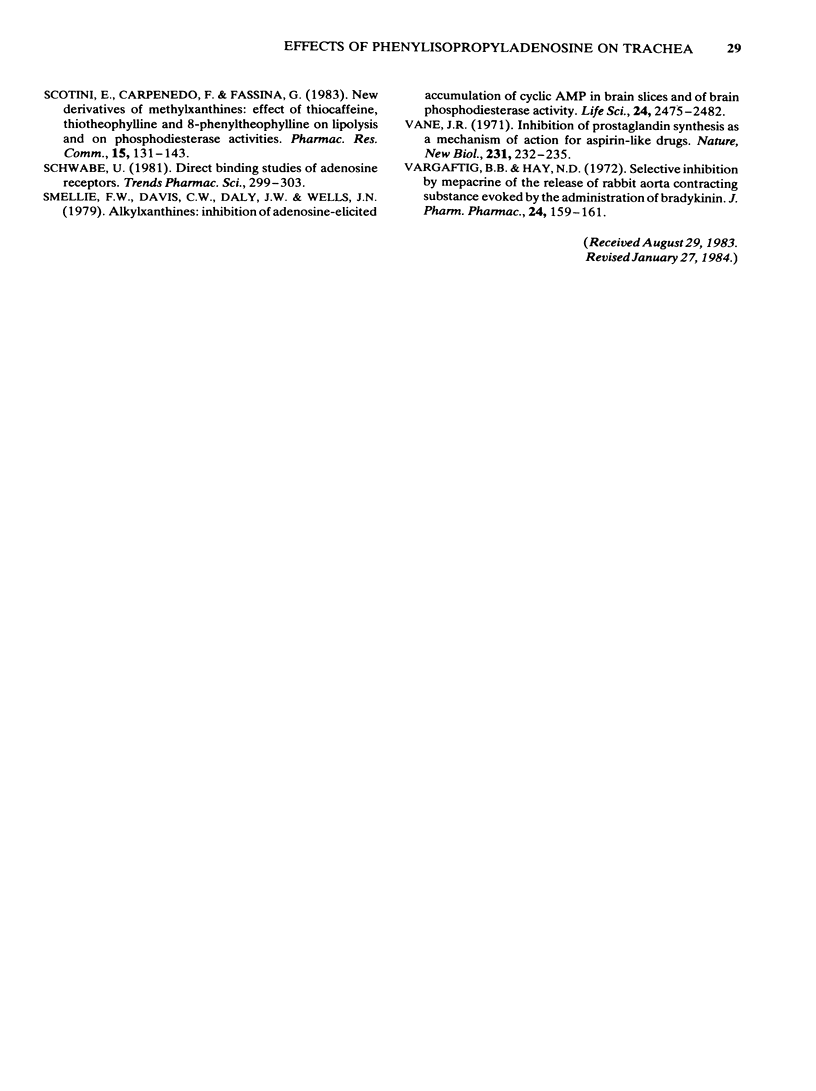Abstract
The effect of (-)-N6-phenylisopropyl adenosine (PIA), a metabolically stable P1-receptor agonist, was investigated on guinea-pig isolated trachea. PIA showed two opposite effects: contraction, evident at low concentrations (10(-7) to 2-5 X 10(-6) M), and relaxation at higher doses. Relaxation by PIA was antagonized in an apparently competitive manner by two antagonists of extracellular (P1) adenosine receptors: theophylline (Theo) and 8-phenyltheophylline (PT). Contraction by PIA was not inhibited by methylxanthines and was not mediated by stimulation of cholinergic or histaminergic systems. Inhibitors of arachidonic acid cascade acting at different levels, i.e. indomethacin, nordihydroguaiaretic acid (NDGA) and BW755C, all inhibited the contraction by PIA, while they potentiated the relaxation in a concentration-dependent manner. Mepacrine, an inhibitor of phospholipase A2, inhibited the contraction by PIA, but did not affect the relaxation. These results indicate that the contractile effect induced by PIA is supported by an indirect mechanism involving the release of arachidonic acid derivatives (via P2-purinoceptor?). Thus the balance between the two opposite effects of adenosine on tracheal tone is possibly modulated by the prostaglandin turnover.
Full text
PDF






Selected References
These references are in PubMed. This may not be the complete list of references from this article.
- Armour C. L., Nicholls I. J., Schellenberg R. R. The effects of salbutamol, theophylline and FPL55712 on leukotriene contraction of guinea pig trachea. Eur J Pharmacol. 1982 Aug 27;82(3-4):229–232. doi: 10.1016/0014-2999(82)90519-2. [DOI] [PubMed] [Google Scholar]
- Brown C. M., Collis M. G. Evidence for an A2/Ra adenosine receptor in the guinea-pig trachea. Br J Pharmacol. 1982 Jul;76(3):381–387. doi: 10.1111/j.1476-5381.1982.tb09231.x. [DOI] [PMC free article] [PubMed] [Google Scholar]
- Bruns R. F. Adenosine antagonism by purines, pteridines and benzopteridines in human fibroblasts. Biochem Pharmacol. 1981 Feb 15;30(4):325–333. doi: 10.1016/0006-2952(81)90062-9. [DOI] [PubMed] [Google Scholar]
- Bruns R. F., Daly J. W., Snyder S. H. Adenosine receptor binding: structure-activity analysis generates extremely potent xanthine antagonists. Proc Natl Acad Sci U S A. 1983 Apr;80(7):2077–2080. doi: 10.1073/pnas.80.7.2077. [DOI] [PMC free article] [PubMed] [Google Scholar]
- Cameron A. R., Kirkpatrick C. T. A study of excitatory neuromuscular transmission in the bovine trachea. J Physiol. 1977 Sep;270(3):733–745. doi: 10.1113/jphysiol.1977.sp011979. [DOI] [PMC free article] [PubMed] [Google Scholar]
- Christie J., Satchell D. G. Purine receptors in the trachea: is there a receptor for ATP? Br J Pharmacol. 1980 Dec;70(4):512–514. doi: 10.1111/j.1476-5381.1980.tb09768.x. [DOI] [PMC free article] [PubMed] [Google Scholar]
- Coburn R. F., Tomita T. Evidence for nonadrenergic inhibitory nerves in the guinea pig trachealis muscle. Am J Physiol. 1973 May;224(5):1072–1080. doi: 10.1152/ajplegacy.1973.224.5.1072. [DOI] [PubMed] [Google Scholar]
- Coleman R. A. Effects of some purine derivatives on the guinea-pig trachea and their interaction with drugs that block adenosine uptake. Br J Pharmacol. 1976 May;57(1):51–57. doi: 10.1111/j.1476-5381.1976.tb07655.x. [DOI] [PMC free article] [PubMed] [Google Scholar]
- Coleman R. A., Levy G. P. A non-adrenergic inhibitory nervous pathway in guinea-pig trachea. Br J Pharmacol. 1974 Oct;52(2):167–174. doi: 10.1111/j.1476-5381.1974.tb09697.x. [DOI] [PMC free article] [PubMed] [Google Scholar]
- Coleman R. A. Purine antagonists in the identification of adenosine-receptors in guinea-pig trachea and the role of purines in non-adrenergic inhibitory neurotransmission. Br J Pharmacol. 1980 Jul;69(3):359–366. doi: 10.1111/j.1476-5381.1980.tb07022.x. [DOI] [PMC free article] [PubMed] [Google Scholar]
- Farmer J. B., Farrar D. G. Pharmacological studies with adenine, adenosine and some phosphorylated derivatives on guinea-pig tracheal muscle. J Pharm Pharmacol. 1976 Oct;28(10):748–752. doi: 10.1111/j.2042-7158.1976.tb04040.x. [DOI] [PubMed] [Google Scholar]
- Flower R. J. Drugs which inhibit prostaglandin biosynthesis. Pharmacol Rev. 1974 Mar;26(1):33–67. [PubMed] [Google Scholar]
- Folco G. C., Omini C., Viganó T., Brunelli G., Rossoni G., Berti F. Biological activity of leukotriene C4 in guinea pigs: in vitro and in vivo studies. Adv Prostaglandin Thromboxane Leukot Res. 1982;9:153–167. [PubMed] [Google Scholar]
- Fredholm B. B., Persson C. G. Xanthine derivatives as adenosine receptor antagonists. Eur J Pharmacol. 1982 Jul 30;81(4):673–676. doi: 10.1016/0014-2999(82)90359-4. [DOI] [PubMed] [Google Scholar]
- Griffith S. G., Meghji P., Moody C. J., Burnstock G. 8-phenyltheophylline: a potent P1-purinoceptor antagonist. Eur J Pharmacol. 1981 Oct 15;75(1):61–64. doi: 10.1016/0014-2999(81)90346-0. [DOI] [PubMed] [Google Scholar]
- Hamberg M. On the formation of thromboxane B2 and 12l-hydroxy-5,8,10,14-eicosatetraenoic acid (12 ho-20:4) in tissues from the guinea pig. Biochim Biophys Acta. 1976 Jun 22;431(3):651–654. doi: 10.1016/0005-2760(76)90232-0. [DOI] [PubMed] [Google Scholar]
- Higgs G. A., Flower R. J., Vane J. R. A new approach to anti-inflammatory drugs. Biochem Pharmacol. 1979 Jun 15;28(12):1959–1961. doi: 10.1016/0006-2952(79)90651-8. [DOI] [PubMed] [Google Scholar]
- Horton E. W. Prostaglandins and smooth muscle. Br Med Bull. 1979 Sep;35(3):295–300. doi: 10.1093/oxfordjournals.bmb.a071591. [DOI] [PubMed] [Google Scholar]
- Kamikawa Y., Shimo Y. Mediation of prostaglandin E2 in the biphasic response to ATP of the isolated tracheal muscle of guinea-pigs. J Pharm Pharmacol. 1976 Apr;28(4):294–297. doi: 10.1111/j.2042-7158.1976.tb04156.x. [DOI] [PubMed] [Google Scholar]
- Lefort J., Vargaftig B. B. Role of platelets in aspirin-sensitive bronchoconstriction in the guinea-pig; interactions with salicylic acid. Br J Pharmacol. 1978 May;63(1):35–42. doi: 10.1111/j.1476-5381.1978.tb07771.x. [DOI] [PMC free article] [PubMed] [Google Scholar]
- Londos C., Wolff J. Two distinct adenosine-sensitive sites on adenylate cyclase. Proc Natl Acad Sci U S A. 1977 Dec;74(12):5482–5486. doi: 10.1073/pnas.74.12.5482. [DOI] [PMC free article] [PubMed] [Google Scholar]
- Richardson J. B., Bouchard T. Demonstration of a nonadrenergic inhibitory nervous system in the trachea of the guinea pig. J Allergy Clin Immunol. 1975 Dec;56(6):473–480. doi: 10.1016/0091-6749(75)90065-2. [DOI] [PubMed] [Google Scholar]
- Scotini E., Carpenedo F., Fassina G. New derivatives of methyl-xanthines: effect of thiocaffeine thiotheophylline and 8-phenyltheophylline on lipolysis and on phosphodiesterase activities. Pharmacol Res Commun. 1983 Feb;15(2):131–143. doi: 10.1016/s0031-6989(83)80055-1. [DOI] [PubMed] [Google Scholar]
- Smellie F. W., Davis C. W., Daly J. W., Wells J. N. Alkylxanthines: inhibition of adenosine-elicited accumulation of cyclic AMP in brain slices and of brain phosphodiesterase activity. Life Sci. 1979 Jun 25;24(26):2475–2482. doi: 10.1016/0024-3205(79)90458-2. [DOI] [PubMed] [Google Scholar]
- Vane J. R. Inhibition of prostaglandin synthesis as a mechanism of action for aspirin-like drugs. Nat New Biol. 1971 Jun 23;231(25):232–235. doi: 10.1038/newbio231232a0. [DOI] [PubMed] [Google Scholar]
- Vargaftig B. B., Hai N. D. Selective inhibition by mepacrine of the release of "rabbit aorta contracting substance" evoked by the administration of bradykinin. J Pharm Pharmacol. 1972 Feb;24(2):159–161. doi: 10.1111/j.2042-7158.1972.tb08953.x. [DOI] [PubMed] [Google Scholar]


